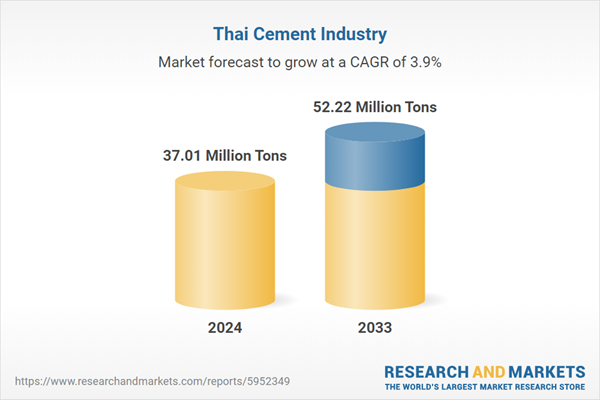Thailand Cement market currently, in 2023, has witnessed an HHI of 9071, Which has decreased substantially as compared to the HHI of 9670 in 2017. The market is moving towards Highly concentrated. Herfindahl index measures the competitiveness of exporting countries. The range lies from 0 to 10000, where a lower index number represents a larger number of players or exporting countries in the market while a large index number means fewer numbers of players or countries exporting in the market. Thailand's cement industry is characterized by a diverse range of manufacturers, including both domestic players and multinational corporations. Major companies such as Siam Cement Group (SCG), Siam City Cement (SCCC), and TPI Polene dominate the market, alongside several smaller players.
One of the key drivers of Thailand's cement industry is the booming construction sector, fueled by rapid urbanization, industrialization, and government infrastructure projects. The country's expanding population, coupled with increasing investments in residential, commercial, and public infrastructure projects, has created a sustained demand for cement.
Thailand's cement industry is known for its adherence to international quality standards and adoption of advanced manufacturing technologies. Many cement plants in the country are equipped with state-of-the-art facilities, ensuring high efficiency, productivity, and environmental sustainability.
Moreover, Thailand's cement industry has been proactive in implementing sustainable practices, including alternative fuel usage, waste heat recovery, and carbon emissions reduction initiatives. This commitment to sustainability aligns with global trends towards greener and more environmentally responsible manufacturing processes.
In recent years, Thailand's cement industry has also focused on expanding its presence in international markets, leveraging its competitive advantages in terms of cost-efficiency, product quality, and logistics infrastructure. Export opportunities to neighboring countries in Southeast Asia and beyond have further fueled the growth of the industry.
In 2023, Thailand's cement production will be about 35.42 million tons, down from 2022. The publisher expects Thailand's cement production to reach about 37.01 million tons in 2024. In 2033 Thailand's cement production will reach 52.22 million tons, a CAGR of about 3.9% from 2024 to 2033. Drivers of growth in the Thai cement industry in the coming years include rising demand for cement in the Thai domestic market and rising exports of Thai cement.
However, like any other industry, Thailand's cement sector also faces challenges, including fluctuating raw material costs, regulatory compliance, and competition from imports. Nevertheless, with its strong fundamentals, technological advancements, and strategic vision, the Thai cement industry continues to thrive, playing a crucial role in driving the country's economic progress and infrastructure development.
Topics covered:
- Thailand Cement Industry Overview
- Economic environment and policy environment of cements in Thailand
- Thailand cement market size from 2019 to 2023
- Analysis of major Thailand cement manufacturers
- Key Drivers and Market Opportunities of Thailand’s Cement Industry
- What are the key drivers, challenges and opportunities for the Thailand cement industry during the forecast period 2024-2033?
- What is the expected revenue of the Thailand Cement market during the forecast period 2024-2033?
- What strategies are adopted by the key players in the market to increase their market share in the industry?
- Which segment of the Thailand Cement Market is expected to dominate the market in 2033?
- Thailand Cement Market Forecast from 2024 to 2033
- What are the main headwinds facing Thailand’s cement industry?
Table of Contents
Companies Mentioned
- Siam Cement Group (SCG)
- TPI Polene Public Company Limited
- Siam City Cement Public Company Limited (SCCC)
- Cementhai SCT
- Asia Cement Public Company Limited
Methodology
Background research defines the range of products and industries, which proposes the key points of the research. Proper classification will help clients understand the industry and products in the report.
Secondhand material research is a necessary way to push the project into fast progress. The analyst always chooses the data source carefully. Most secondhand data they quote is sourced from an authority in a specific industry or public data source from governments, industrial associations, etc. For some new or niche fields, they also "double-check" data sources and logics before they show them to clients.
Primary research is the key to solve questions, which largely influence the research outputs. The analyst may use methods like mathematics, logical reasoning, scenario thinking, to confirm key data and make the data credible.
The data model is an important analysis method. Calculating through data models with different factors weights can guarantee the outputs objective.
The analyst optimizes the following methods and steps in executing research projects and also forms many special information gathering and processing methods.
1. Analyze the life cycle of the industry to understand the development phase and space.
2. Grasp the key indexes evaluating the market to position clients in the market and formulate development plans
3. Economic, political, social and cultural factors
4. Competitors like a mirror that reflects the overall market and also market differences.
5. Inside and outside the industry, upstream and downstream of the industry chain, show inner competitions
6. Proper estimation of the future is good guidance for strategic planning.

LOADING...
Table Information
| Report Attribute | Details |
|---|---|
| No. of Pages | 60 |
| Published | April 2024 |
| Forecast Period | 2024 - 2033 |
| Estimated Market Value in 2024 | 37.01 Million Tons |
| Forecasted Market Value by 2033 | 52.22 Million Tons |
| Compound Annual Growth Rate | 3.9% |
| Regions Covered | Thailand |
| No. of Companies Mentioned | 5 |









